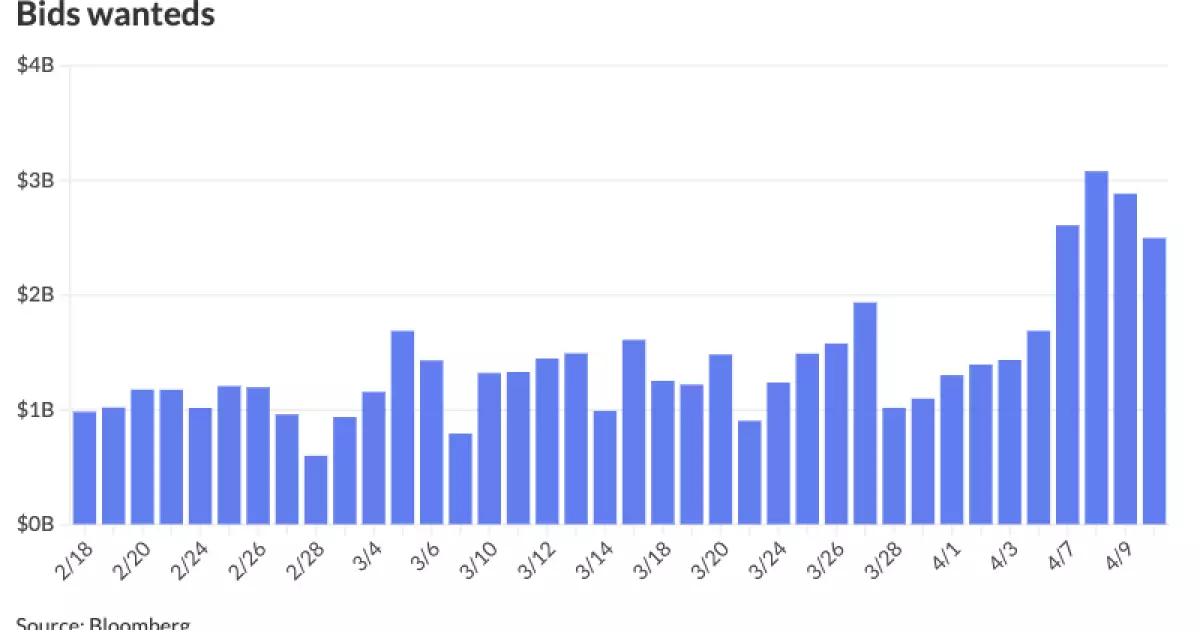The municipal bond market has found itself in a quagmire, primarily due to the unpredictable effects of President Donald Trump’s trade policies. Once considered a safe haven, high-grade munis now resemble a precarious tightrope walk where yields are skyrocketing and investors are left in the wake of constant fluctuations. According to analysts at J.P. Morgan, we’re observing a market characterized by unprecedented volatility that is largely rooted in a combination of forced selling and policy indecision. A staggering 45 basis points hike in 10-year U.S. Treasury rates within just one week has sent shockwaves through the financial ecosystem. The unfortunate reality here is that the direction we’ve taken feels more reactive than strategic; policymakers appear to be fishing in murky waters, blindfolded.
The surge in yields has plunged municipal bonds to their most elevated levels in over a decade, a concerning metric that hints at underlying economic instability. The sell-off observed this week was not merely a market correction, but rather a symptom of deeper issues—widespread ETF outflows, legislative unpredictability, and increased supply of tax-exempt bonds have all conspired to diminish investor confidence. Yet, despite these setbacks, the dynamics of the market, exacerbated by external shocks such as tariffs, illustrate a lack of foresight and planning among decision-makers.
Market Psychology and Volatility
We’ve reached a tipping point in the municipal bond market, reminiscent of the tumultuous days of the COVID-19 pandemic. It’s unsettling to note that this week has witnessed among the largest daily sell-offs we’ve seen in the last 15 years. Such moments are often polarization points, wherein an investor’s perception of risk engenders rapid decision-making, leading to panic selling. Analysts from Barclays have observed significant swings within the AAA-rated curve, a trend that underscores a growing divergence in asset behavior. The very essence of conservatism in investing—traditionally embodied in high-grade munis—appears to have been thrown out in this environment of fear and uncertainty.
This pattern raises an unsettling question: Are local governments setting themselves up for failure by relying too heavily on instruments that are now fraught with instability? The high yield market has emerged as a paradox; while lower-rated bonds outperform in this crisis, it tells us something deeply troubling. The flight to quality, which we would expect in tumultuous times, shows signs of shifting. Are we witnessing a sea change in how municipal bonds are perceived? The high-risk tolerance demonstrated by investors could lead to disastrous effects down the road, particularly if these shifts endure beyond the current volatility.
Investor Sentiment: The New Norm?
The current sentiment raises a pertinent discussion about whether we are now witnessing a toxic normalization of extreme volatility. Daily performances that swing wildly between gains and losses condition investors to expect the unexpected. If past precedents hold, such as after Trump’s election or the onset of COVID-19, the market may ultimately stabilize. However, there’s a sharp caveat: the path to recovery often requires a reevaluation of valuation metrics that, in this case, has yet to occur.
Investors generally gravitate toward treasures viewed as safe, but when even high-grade bonds falter, it unveils a potentially paralyzing psychological barrier. Decisions that once relied on well-established economic fundamentals are now increasingly influenced by uncertain geopolitical climates and erratic fiscal policy. The willingness of capital providers to commit resources here is fundamentally undermined by a chaotic landscape where predictability has become a foreign concept. The anticipation of liquidity has been transformed into a hesitance to engage, which brings additional layers of complexities in capital allocation.
The Underwriter’s Dilemma
In the throes of this volatility, underwriters are caught in a maelstrom. As Jock Wright insightfully pointed out, we’ve reached a point where the very foundation of underwriting bonds—a reliance on historical trends and metrics—has been destabilized. Liquidity is evaporating, making it arduous for any underwriter to justify large commitments under the current unpredictable regime. This environment is compounded by fears that any bonds issued today could depreciate overnight.
The art of underwriting has always involved capturing nuances in market sentiment, but what happens when the market itself transforms into a relentless creature of chaos? Potential issuers are now at the mercy of unpredictability; every deal becomes a gamble, where the stakes are no longer aligned with historical patterns. The underwriter’s dilemma reflects broader economic concerns and calls into question whether we are retrogressively reshaping the municipal bond market into something fundamentally unstable.
In this era of instability, the municipal bond market finds itself at a crossroads. It remains essential for stakeholders—both investors and policymakers—to cultivate a more stable and predictable environment. The alarming trends observed this week should serve as a clarion call to reconsider the protocols and policies governing municipal bonds in these volatile times.


Leave a Reply